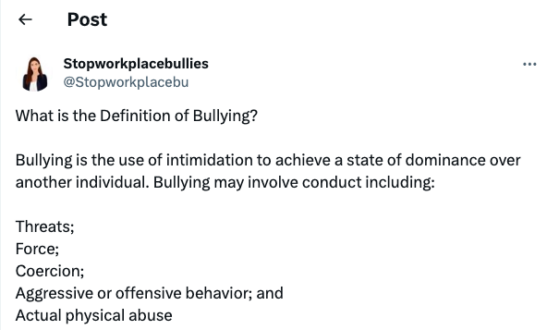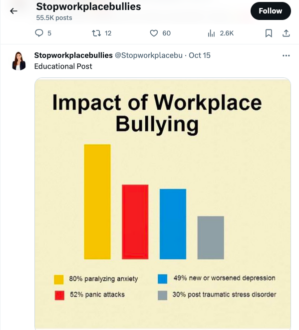
According to @Stopworkplacebu, workplace bullying involves the use of intimidating tactics to dominate others, ranging from verbal aggression and threats to physical abuse and coercion. This harmful behaviour creates toxic environments where employees feel unsafe, undermined, and unable to thrive.
The impact of workplace bullying extends to serious consequences, including paralyzing anxiety and panic attacks, among other afflictions, as highlighted below:
Sussan Mann, a seasoned leadership coach, delves deeper into this issue, describing workplace bullying as a dehumanizing process centered on power and control.
It doesn’t solely target an employee’s professional aspect but also their character, dignity, and overall integrity as a human being. It can be a profoundly traumatic experience.
Women-on-Women workplace bullying
Jennifer Hancock, founder of Humanist Learning Systems, bravely shared her firsthand experience with a bullying female supervisor. Hancock was targeted by her HR manager, the very person meant to prevent abuse. At first, Hancock was baffled and deeply confused by the inexplicable harassment. Over time, the bullying corroded her confidence and heightened her anxiety.
Hancock felt increasingly helpless and isolated. Though coworkers witnessed the toxicity, they feared losing their jobs if they dared speak up.
Turnover in Hancock’s role was extremely low, signalling something was wrong. But the company culture deterred intervention. Through Hancock’s courage to share her story, she lends a human face and voice to workplace bullying. Her vulnerability spotlights the traumatic impacts bullying inflicts, especially when perpetrated by those in power. Hancock models how we as a society must stand up to injustice and build workplaces where respect and human dignity reign.
In today’s workplaces, women-on-women workplace bullying stands out as a pressing concern. For instance, when a female supervisor constantly criticizes and undermines her female subordinates, this is often referred to as the “Queen Bee Syndrome.” This term isn’t a mere opinion but a descriptive phrase used to illustrate
the phenomenon where women in positions of authority exhibit bullying tendencies toward their female colleagues.
This behaviour often springs from deep-seated feelings of insecurity and competition in the professional space. Understanding the Queen Bee Syndrome is pivotal to addressing this issue, involving the recognition of intricate power dynamics and underlying insecurity driving these actions.
Furthermore, it’s important to identify the specific tactics employed in workplace bullying. These tactics may include exclusion, rumor-spreading, harsh criticism, and wrongfully taking credit for others’ work. Such behaviours foster a hostile work environment that negatively impacts both the victims and overall productivity.
How to deal with women on women bullying
Addressing women-on-women workplace bullying demands a comprehensive approach. Commence by carefully documenting each incident to maintain a clear record. When you feel comfortable, engage in a direct conversation with the bully to assert your right to be treated with respect.
Seek support from colleagues, friends, or family members who can provide guidance and understanding.
If the issue persists or escalates, don’t hesitate to report it to your supervisors or the HR department, emphasizing the importance of a healthy work environment. Prioritize self-care through activities such as regular exercise, meditation, or seeking professional assistance to cope with the emotional toll of bullying.
Always remember that tackling this challenge necessitates a personalized approach that prioritizes mental and emotional well-being.
Additionally, there are legislations like the Healthy Workplace Bill in the US designed to combat workplace bullying and promote a respectful, inclusive workplace. The WBI Healthy Workplace Bill is an organization advocating for the implementation of the Healthy Workplace Bill (HWB) in U.S. Its goal is to address workplace bullying and improve legal protections against it.
The HWB represents a significant change in US. employment law, aiming to combat workplace bullying, which is not adequately covered by existing laws.
It was written by Suffolk University Law Professor David C. Yamada and is promoted by the Workplace Bullying Institute (WBI), a network of volunteer citizen lobbyists.
This article was inspired by Jim Stroud’s The Recruiting Life.









